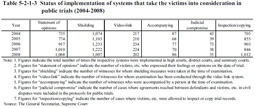| Previous Next Index Image Index Year Selection | |
|
|
2 Victim participation, etc. in trials (1) Victim participation system, etc.Since 2000 courts have provided victims, etc. with the opportunity to express themselves, in principle, on the date of trial if they wish to express their feelings on the damage caused by the offense and opinions on the pertinent case. Table 5-2-1-3 shows the status of implementation of the above mentioned system over the last five years. In addition, the Code of Criminal Procedure was amended (by Act No. 95 of 2007) and a system established that allows, upon decision of the court, the victims, etc. of certain offenses to attend the court and directly question defendants on the trial date, etc. (hereinafter referred to “victim participation system” in this subsection). This system has been implemented since December 2008. The Act on Measures Incidental to Criminal Procedures for Purpose of Protection of Rights and Interests of Crime Victims (Act No. 75 of 2000; hereinafter referred to as the “Crime Victims, etc. Protection Act”) and the Comprehensive Legal Support Act (Act No. 74 of 2004) were both amended (by Act No. 19 of 2008) to enable victims, etc., depending on their financial resources, to apply for court-appointed attorneys at law to act on their behalf when they participate in criminal proceedings under this system. During the period from the implementation of the victim participation system to the end of March 2009, 84 victims, etc. had offered to participate in criminal trials, with 82 being accepted and nine entrusted to court-appointed attorneys at law for victims (Source: The General Secretariat, Supreme Court). (2) Witness protection, etc. Victims often appear as witnesses at trials. There are various systems to protect witnesses at the time of examination, including the following: a system to take measures to shield the witness from the defendant or from the public in the court; a system in which the witness remains in a different room and is examined via audiovisual communication through the transmission of images and sound (video-link system); and a system that allows a witness to be accompanied by a person whom the court deems appropriate. Table 5-2-1-3 shows the status of implementation of the above mentioned systems over the last five years. In addition, a system wherein the names, etc. of victims are protected at criminal proceedings has also been implemented since December 26, 2007, and was used with 2,490 persons in 2008 (Source: The General Secretariat, Supreme Court). (3) Judicial compromise and damage compensation order system The defendants and victims, etc. in a criminal case may jointly request that they come to an agreement in a civil dispute related to the criminal case and they request the fact to be included in the protocol for a public trial. Any such agreement included in the protocol has the same effect as a compromise in a trial (judicial compromise). Victims, etc. can therefore take compulsory execution procedures using the protocol for a public trial if the defendant fails to perform the agreed duties. Table 5-2-1-3 shows the status of implementation of the above mentioned systems over the last five years. In addition, for certain serious offenses, a system has been implemented since December 2008 whereby the victims, etc. can request damage compensation so that after a conviction has been rendered in a criminal trial, the court proceeds to make a decision on the compensation request by examining the criminal trial case records. During the period of implementation of the system to the end of March, 2009, 31 requests were received and 10 were disposed (Source: The General Secretariat, Supreme Court). (4) Inspection/copying of trial records Conventionally, inspections or copying of trial records has been permitted upon request from victims, etc. only when the courts find sufficient reasons and grounds to grant such request. The scope of applicable cases has been expanded since December 26, 2007 so that in principle courts now allow victims, etc. to inspect or copy all trial records (victims, etc. of other offenses of similar kinds by the same defendants are also allowed to inspect or copy the records if the court deems it necessary and appropriate in exercising their right to claim compensation for damage). Table 5-2-1-3 shows the number of cases in which victims, etc. inspected/copied trial records over the last five years. Trial records of non-prosecuted cases are in principle not to be disclosed. However, there are cases where victims, etc. require objective evidence in exercising their right to claim compensation for damage or other rights in civil lawsuits. In light of this, public prosecutors offices can permit inspections or copying of such evidence if deemed appropriate and to the extent that it does not to impose any risk of invading the privacy of any persons concerned. In addition, since December 1, 2008, victims, etc. are in principle allowed to inspect objective evidence in non-prosecuted cases pertaining to criminal cases in which the victim participation system is applicable, even if the aim is to “identify the details of the case.” Table 5-2-1-3 Status of implementation of systems that take the victims into consideration in public trials (2004–2008) |
